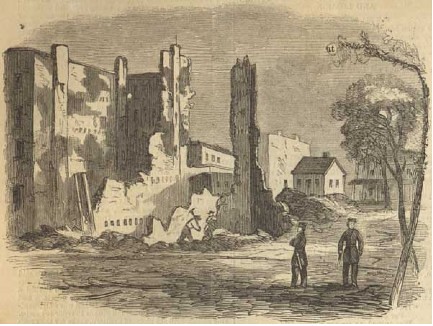 Ruins of the Provost-Marshall's office. Published in Harper's Weekly, August 1, 1863.
Ruins of the Provost-Marshall's office. Published in Harper's Weekly, August 1, 1863.
Sunday, April 12, 2009
Aftermath
This 4-5 day riot was destructive, to say the least. The official death toll, which is arguable, reached 119. However, many sources differ in the number, especially news reports at that time which exaggerated it to be thousands. These protests have shown one of the most destructive (in terms of human loss) urban civil unrest cases in U.S. history. However, federal officials rescheduled the draft lottery starting that August. The rioters were severely punished, with 67 persons convicted with differing jail term lengths. When the draft was resumed, the federal government stationed 10,000 troops in the city. The draft lottery took place in late August and went peaceably. The Democratic Party was able to persuade the government to reduce the lottery from 26,000 to 12,000 men. In an effort to ease the weight of the draft, the Common Council approved a $3 million exemption fund to help draftees find replacements, but Mayor Opdyke refused. This caused the Board of Supervisors to make their own exemption committee to pay for similar benefits for almost any man who did not wish to fight. New York City's African-American population also took a severe hit. Before the riots started, more than 12,000 resided in the city. After the protests in which most violence was directed at African-Americans, the population dipped below 10,000. However, the 20th Regiment U.S. Colored Troops were formed, making that the first black volunteer force ever to emerge from New York City. After parading through the town, they defended the Union in New Orleans.
 Ruins of the Provost-Marshall's office. Published in Harper's Weekly, August 1, 1863.
Ruins of the Provost-Marshall's office. Published in Harper's Weekly, August 1, 1863.
 Ruins of the Provost-Marshall's office. Published in Harper's Weekly, August 1, 1863.
Ruins of the Provost-Marshall's office. Published in Harper's Weekly, August 1, 1863.
Subscribe to:
Post Comments (Atom)

No comments:
Post a Comment